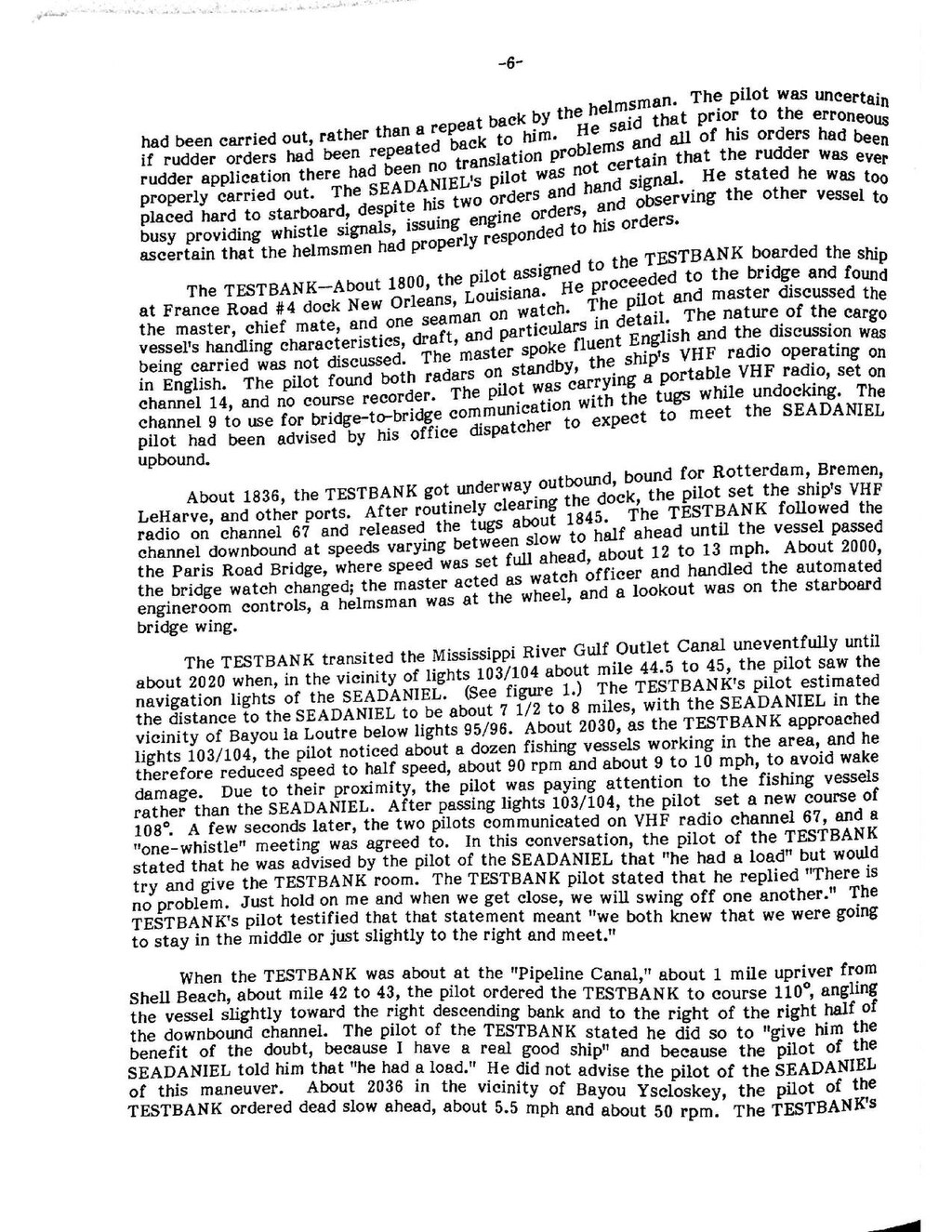had been carried out, rather than a repeat back by the helmsman. The pilot was uncertain if rudder orders had been repeated back to him. He said that prior to the erroneous rudder application there had been no translation problems and all of his orders had been properly carried out. The Seadaniel's pilot was not certain that the rudder was ever placed hard to starboard, despite his two orders and hand signal. He stated he was too busy providing whistle signals, issuing engine orders, and observing the other vessel to ascertain that the helmsman had properly responded to his orders.
The Testbank—About 1800, the pilot assigned to the Testbank boarded the ship at France Road #4 dock New Orleans, Louisiana. He proceeded to the bridge and found the master, chief mate, and one seaman on watch. The pilot and master discussed the vessel's handling characteristics, draft, and particulars in detail. The nature of the cargo being carried was not discussed. The master spoke fluent English and the discussion was in English. The pilot found both radars on standby, the ship's VHF radio operating on channel 14, and no course recorder. The pilot was carrying a portable VHF radio, set on channel 9 to use for bridge-to-bridge communication with the tugs while undocking. The pilot had been advised by his office dispatcher to expect to meet the Seadaniel upbound.
About 1836, the Testbank got underway outbound, bound for Rotterdam, Bremen, LeHarve, and other ports. After routinely clearing the dock, the pilot set the ship's VHF radio on channel 67 and released the tugs about 1845. The Testbank followed the channel downbound at speeds varying between slow to half ahead until the vessel passed the Paris Road Bridge, where speed was set full ahead, about 12 to 13 mph. About 2000, the bridge watch changed; the master acted as watch officer and handled the automated engineroom controls, a helmsman was at the wheel, and a lookout was on the starboard bridge wing.
The Testbank transited the Mississippi River Gulf Outlet Canal uneventfully until about 2020 when, in the vicinity of lights 103/104 about mile 44.5 to 45, the pilot saw the navigation lights of the Seadaniel. (See figure 1.) The Testbank's pilot estimated the distance to the Seadaniel to be about 7 1/2 to 8 miles, with the Seadaniel in the vicinity of Bayou la Loutre below lights 95/96. About 2030, as the Testbank approached lights 103/104, the pilot noticed about a dozen fishing vessels working in the area, and he therefore reduced speed to half speed, about 90 rpm and about 9 to 10 mph, to avoid wake damage. Due to their proximity, the pilot was paying attention to the fishing vessels rather than the Seadaniel. After passing lights 103/104, the pilot set a new course of 108º. A few seconds later, the pilots communicated on VHF radio channel 67, and a "one-whistle" meeting was agreed to. In this conversation, the pilot of the Testbank stated that he was advised by the pilot of the Seadaniel that "he had a load" but would try and give the Testbank room. The Testbank pilot stated taht he replied "There is no problem. Just hold on me and when we get close, we will swing off one another." The Testbank's pilot testified that the statement meant "we both knew that we were going to stay in the middle or just slightly to the right and meet."
When the Testbank was about at the "Pipeline Canal," about 1 mile upriver from Shell Beach, about mile 42 to 43, the pilot ordered the Testbank to course 110º, angling the vessel slightly toward the right descending bank and to the right of the right half of the downbound channel. The pilot of the Testbank stated that he did so to "give him the benefit of the doubt, because I have a real good ship" and because the pilot of the Seadaniel told him that "he had a load." He did not advise the pilot of the Seadaniel of this maneuver. About 2036 in the vicinity of Bayou Yscloskey, the pilot of the Testbank ordered dead slow ahead, about 5.5 mph and about 50 rpm. The Testbank's
